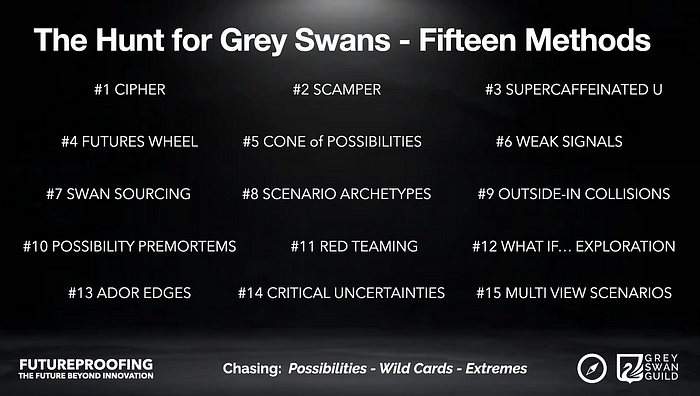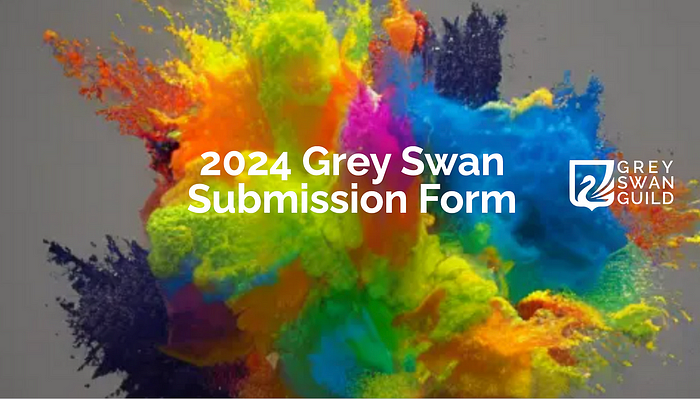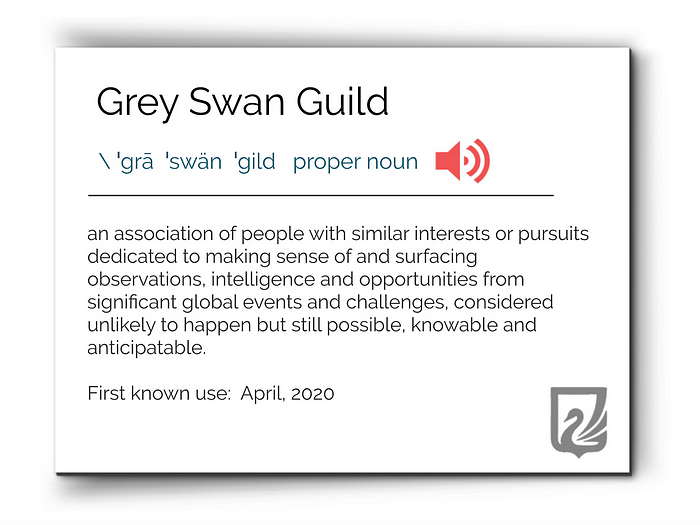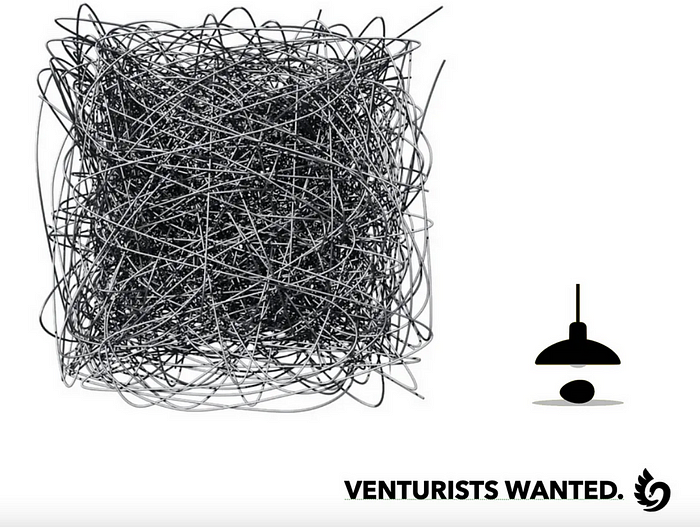The Hunt for Grey Swans — Top 15 Methods & Frameworks — #9 Outside-In Collisions
Chasing Possibilities, Wild Cards and Extremes by Mashing Together the Outside Winds
Author: Sean Moffitt, Grey Swan Guild Founder and CEO, Cygnus Ventures

“It is a narrow mind which cannot look at a subject from various points of view.” — George Eliot
Ever look outside from a well-lit house on a winter’s night. A strange phenomenon exists where the outside looks like a deep and murky shade of dark. It might even be considered foreboding and scary (confession: at least as a somewhat agitated kid growing up in the city from the comparable comfort and security of a bedroom).
A strange illusion distorts our outside views. There are really three things at play here, which act as powerful metaphors for how many of us think about causes and effects in our professional lives.
- We have an environment issue — things simply seem scarier at night (at this time of year Halloween plays on this nocturnal fear). One reason is that our vision is limited in the dark — we cannot see what we need to see. Evolutionarily, humans have developed a natural fear of the dark as a way to protect themselves from potential dangers lurking in the nighttime. Our minds can also amplify phobias, as nighttime is often associated with the unknown and the supernatural in many cultures. Metaphorically, we fear our professional outside environments like many of us fear the night. Frequently inside companies we see the outside world as unwelcoming with potential peril at every corner. It’s much more comforting operating with a strong defensible and familiar perimeter from our safer internal cores — despite the resulting distortion caused from these inside-out perspectives.
- We have a prism issue — the glass of a window itself reflects lot more light at night as viewed from the inside, further distorting our view of the outside world. Similarly, most inside-out organizational thinking starts with a challenge or issue as we see it at first, and then only explore solutions within that initial mental frame. Commonly afflicted by such human cognition concepts such as anchoring bias, attribution bias and self-serving bias (also defined below), the reflecting lens that we peer through distorts and obscures important realities.
- We have an operator issue — when you look outside at night, your optics change to adjust. Your iris opens wider to allow your pupils to take in more light and the rods in your eyes primarily take over your vision since they’re more sensitive to low light — but they can’t see color, so your night vision is almost completely black and white. This is akin to the mindset change people have had when they become part of an organization. Over time, their mindset changes and adjusts to conform to the orthodoxy of the inside. Executives, managers and staff cease to see the reality in how the world operates. We end up seeing a black-and-white view, not the very nuanced world as it is.
Change versatility of companies frequently scores low on many organizational surveys and is often due to a dependency on inside-out thinking with limited room for change. Plenty of cognitive biases make themselves known to such close-mindedness:
- anchoring bias — the reliance too heavily on information that we receive early in the decision-making process.
- confirmation bias —the tendency to search for, interpret, favor, and recall information in a way that confirms or supports our prior beliefs or values - essentially, we try to prove ourselves right.
- fundamental attribution error — we over-attribute the behaviors of others to their personality, and under-attribute them to their situation or context.
- self-serving bias — we distort reality in order to protect our egos or advance ourselves.
To grow as a business leader you must know when to shift toward an outside perspective. This is why Outside-in Collisions are important.
Outside-In History and Gaps: The Advancement of STEEPLE or PESTLE Analysis
Outside-In analysis and approaches matter and frequently provide the best windows to better solutions. Harvard professor Francis Aguilar came up with PESTLE/STEEPLE analysis in the mid 1960s as a way to help understand the big picture and as a method to encourage firms to think about the wider environment. The term is an acronym that stands for: Socio-cultural, Technological, Economic, Environmental/ecological, Political factors, Legal and Ethical factors (the latter two added in the 1980s.)
It may appear strange to our more complex minds of the 2020s, but having broad understanding of our environments is really only a half-century-year-old expertise. Quite rightfully Aguilar’s work (and Michael Porter’s work on Five Forces at around the same time) was seen a foundational for innovation, progressive leadership and having a customer-centric approach.
However, a long time has passed since STEEPLE’s development and three gaps have always remained from this work:
- in the desire for simplicity, the originators set too narrow a line for explorations — we have expanded below in our tool to include a much broader list of 25 influences, many influences on the list get overlooked in a slimmer five- or seven-view world.
- it’s not just the peering into these different single pane windows, but particularly in an uncertain world, what do we see when we go beyond the silos? and the limitations of looking at them in isolation and not in combination with each other, and
- although these STEEPLE elements were an early environmental-scanning regimen, no real instructions were ever fully laid out with what you should do with what gets learned?
One way to overcome silo behavior and distinguish yourself as a “boundary spanner” is to build social and relational capital with colleagues outside and across organizational boundaries. This will allow you to scan wider and develop better external peripheral vision, so you can see around corners and act faster.
Here are some other strategic benefits that will propel your career once you invest in and master outside-in thinking.
— People will notice in meetings that you have become more flexible in how you approach issues; your viewpoints will become less same old, same old.
— You will develop more empathy toward other people and their challenges; be it investors customers or partners, seeing and feeling issues through the eyes of another very much requires an outside-in approach.
— You will lead complex negotiations better in search of win-win solutions, you will spend more time thinking about other people’s issues, goals and constraints than your own.
— You will expand your world — opening yourself up to new experiences, different relationships, deeper insights and rekindle the joy of new discoveries will make you a better change agent and innovator.
-You will stay relevant — when the marketplace, workplace or cultures shift, you will not be blindsided and be more ready to jump over the chasms left behind because you will be aware of what is happening in the moment, or better yet, act on them before they arrive.
-You will become a better leader — you will become better at encouraging diverse views, being able to shift your mindset and behaviors for a shifting age; you will humanize your leadership by bringing in your personal experiences and life; and you will be seen as more interesting by your expansive curiosity and knowledge.
How to Get Better as an Outside-In Leader:
Beyond the tools we use, how can we advance our outside-in-ness? Here are seven reflective questions you should be honest about:
- Active Wandering: Do I explore situations that are novel and uncomfortable regularly to find the applicable insights and foresights?
- Beyond Bias: Do I avoid prematurely judging and labeling problems, people and issues? Can I get unstuck from my pre-existing paradigms?
- Embracing the Edge: When dealing with contrarians, hackers, mavericks or prosumers, do you sufficiently apply curiosity and effort to understand them?
- Empathy: Can I easily place myself in the lives of others holistically, emotionally and rationally?
- Post-Identity: Do I avoid badging too much pride in being from a certain demographic, discipline, geography, place or philosophy?
- Situational Awareness: Do I rarely get blindsided, or commonly raise issues others overlook?
- Starting Points: Can I frame challenges from other people’s perspectives? Am I comfortable operating from a blank page?
Let the light of the outside shine into your worlds with a fresh, externally-friendly and new framework Outside In Collisions. Let’s make sure we have scouted and deciphered the world out there, the way it exists, not the way we think it exists.
“It is the obvious which is so difficult to see most of the time. People say ‘It’s as plain as the nose on your face.’ But how much of the nose on your face can you see, unless someone holds a mirror up to you?” -Isaac Asimov
A reminder of the area our continuing Grey Swan series is covering:
Reminder — Grey Swan Definition: Unlikely but knowable key factors, events and developments, capable of being evaluated and validated in advance, with impacts that could positively and/or negatively shake up the world.

Method #9: Outside-In Collisions — 1+1+1=7

Our Outside-In Collisions tool has been built as a reaction to the siloed thinking we often find in our professional and personal lives. As humans we like the confidence we share in what things look like now to our internal lenses. We embrace the tribalism of what we know best without considering its confluence with other things. We enjoy knowing perhaps the obvious one thing that we can see closely offshore. We contemplate only the fate of high probability outcomes to the exclusion of all other future unravellings. This opposing force to these four human oversights is at the heart of Grey Swan thinking.
“Chaos is merely order waiting to be deciphered.” — José Saramago
Invented by: Sean Moffitt, Managing Director, Futureproofing/CEO of Cygnus Ventures with deference to a history of outside-in work by Francis Aguilar, Michael Porter and Wharton Professor George Day and Duke Fuqua Professor Christine Moorman (inventors of the term) mentioned above, and various customer-centric companies who have adopted outside-in thinking as a core cultural tenet (e.g. Virgin, Netflix, Nike).
Category: Landscape research, strategic force analyses, strategic planning and foresight, organizational learning and development.
Why we Love It as a Grey Swan Tool: Outside-in Collisions is a shorthand tool for investing in a fuller view of the outside world without obscuring facets for simplicity sake. It provides the bread crumbs for a fuller analysis BUT also suggests a way to process these by: a) declaring a focused future lens around a particular challenge, time period or deliverable, b) looking at these big forces in combination without getting lost in the weeds, and c) providing three core ways to process these identified forces.
Overcomes the sin of: Going too simple and wide, or too specific and narrow when being inspired externally. Outside-In Collisions strikes the middle ground balance of looking at an organizations’ environment and future. Outside-in Collisions goes one step further than a mere strategic landscape analysis by providing a way to combine and infer big influences and solutions against a shared organizational purpose.
Outside-In Collisions work preceded by:
- In most cases, identifying two or three levels of contributors — an inside team that will do the advance work and consolidate efforts, a core group that will invest themselves in the meat of the collision effort, and potentially, an outside group who can source and validate inputs and/or contribute to and rank outputs.
- Declare a shared strategic lens of observation that will be the central focus of the collisions e.g. a time period in the future, a broad challenge statement, a specific business unit or innovation push, a required deliverable — need a 3 year business plan.
- Research widely the top applicable big forces within the top 25 camps of outside influence (generative AI platforms can now accelerate but not replace this effort) — consider five supported forces or headlines for each area: 1) a dominant influence, 2) a key or commonly accepted #1 influence on your org., 3) the fastest rising influence, 4) an overlooked influence (lower probability of happening but conceivable high impact), and a Grey Swan wild card influence (lowest probability but highest impact). Note: feel free to add a category of outside-in influence if particularly valuable for your organization.
- Share broadly with the organizational core group team the advance analysis and ask members to consider collisions of this set of starting forces, evidence of support, and implications if they collided in this way.
Work followed by:
- Remind team of the strategic lens and have team consider the expanse of influences with that focus in mind — add any key forces missing but keep them to a minimum (e.g. one per contributing person).
- Whether using big real-life boards, or online collaboration tools (e.g. Miro/Mural), have people make five-to-ten combinations (1+1+1) of these forces — ensure each of the forces identified are not within the same category, and that some of these include lower probability or Grey Swan influences.
- Consolidate these triad forces into three types — Trend Riptides — combining these forces in a gradual powerful evolution of a pattern, Perfect Storms — the triggering and unleashing of something new and powerful based on the confluence of forces, Opposing Fronts— forces that combine to resist, provide friction and counter react against the grain of current organizational thinking.
- Collect all collisions for expert team consideration — discussion (as it allows) of the key and most interesting force combinations — for each profiled collision, consider the signals to know when and how this collision could happen; the implications if it did; and what might have to change internally if this environment became real.
- Walkaway and provide a portfolio of top force combinations that underpin future strategic choices with equal consideration for riptides, storms and fronts.
- Subsequent work — return back to this database of collisions in future cycles — auditing what actually happened and using this seed work as a springboard for the next work on that strategic lens.
Facets of the Outside-In Collisions:
We have expanded beyond STEEPLE to orient organizations around outside-in thinking across an expanded 25 different camps of influences (ranked in order of priority for 2024 key forces and visualized above in this article): 1) technology, 2) social culture, 3) economics, 4) environment, 5) societal, 6) geo-political, 7) health, 8) living, 9) energy, 10) security/safety, 11) marketplace, 12) workplace, 13) education, 14) science, 15) resources, 16) design, 17) mobility, 18) agriculture, 19) leisure, 20) media, 21) legal/regulatory, 22) innovation, 23) citizen life, 24) the good, and 25) infrastructure.
Combinations — as mentioned above we have also processed the collision of these forces, akin to weather patterns, in three different ways: trend riptides (progressive evolutions), perfect storms (triggered revolutions) and opposing fronts (counter conventions).
Outputs — with a team of 12 people, you could end up producing an output of 125+ forces specific to your organization, 60–120+ collisions (1/3 riptides, 1/3 storms, 1/3 fronts) and tapping the top 15-25 of these collisions (once again evenly divided among riptides, storms and fronts) to support strategic insights or decisions.
Additional Commentary on Outside-In Collisions:
“Outside-in thinking within organizations is candidly something most companies are not strong at. Cultures resist. Inside-out arrogance prevails. To-do lists get in the way. Paradoxically sometimes the stronger the company culture (generally a good thing), the worse the outside-in thinking. Outside-In Collisions was my attempt at inventing a tool, and an approach, that if followed, could be an activity to navigate the full world out there absent all the organizational angst, and without the late innings inclination for execs and leaders to simply ignore the work and do what they wanted to do all along. ” — Sean Moffitt
Grey Swans — A Month of Specialty Posts:
This is number nine of a set of fifteen posts on different methods and frameworks for chasing Grey Swans. but we have so much other commentary on this valuable but often overlooked chase for the non-obvious:
- I — Grey Swan Week and defining Grey Swans
- II — Our 2023 Report Card of Grey Swans (last year’s review and performance)
- III — Fifteen Ways to Hunt for Grey Swans (methods and frameworks) — #1 CIPHER,
- #2 SCAMPER
- #3 SUPERCAFFEINATED U
- #4 FUTURES WHEEL
- #5 CONE OF POSSIBILITIES
- #6 WEAK SIGNALS
- #7 SWAN SOURCING
- #8 SCENARIO ARCHETYPES
- #9 OUTSIDE-IN COLLISIONS
- #10 POSSIBILITY PREMORTEMS
- #11 RED TEAMING
- #12 WHAT IF … EXPLORATION
- #13 ADOR EDGES
- #14 CRITICAL UNCERTAINTIES
- #15 MULTI-VIEW SCENARIOS
- IV — Fifty Grey Swan Wild Card Influences in 2025 (ranking the categories)
- V — Twelve Grey Swans Revealed (<25%) — Cloudy Swans
- VI — Twelve Grey Swans Revealed (<5%) — Stormy Swans
- VII — Twelve Grey Swans Revealed (<1%) — Shadow Swans
Stay tuned with us here, as well as on our website for all the rundowns.
Participate in our Hunt for Grey Swans
Don’t worry it’s a humane hunt. We have already invited some of our regular contributors to provide us the seeds of what will be our authoritative list of one hundred 2024 Grey Swans.
These are the improbable, disruptive and remote developments that decision makers better keep at least one eye peeled open for so they don’t blindside them. Perhaps you have some you’ve considered yourself.
Be among the most talented and wide-eyed observers. Let us know your Grey Swan additions and we will add them to our annual collection with our 2024 Grey Swan Guild Subnmission Form. Other benefits and collabroations may follow.

Grey Swan Submission Form: https://bit.ly/2024greyswan
Grey Swan Guild — Making Sense of the World and Next Grey Swans
We are the Guild whose mission it is to make sense of the world and next Grey Swans (wild cards, scenarios, early signals).
How we do this is guided by our four values of: aspiration, collaboration, curiosity and purpose.
We bring this to life through four facets of our world-leading Guild experience:
- Intelligence, Content and Publications
- Events, Experiences and Learning Forums
- Global Community and Network
- Experiments and Ventures
Here’s what you can do in the Guild:
Learn about the Guild: https://www.greyswanguild.org/
Read our Content: https://greyswanguild.medium.com/
Attend our Events: https://www.greyswanguild.org/calendar
Become an Official Guild Member: https://bit.ly/gsgsmemberform

The Guild Hub: https://www.greyswanguild.org/
Cygnus Ventures (powered by Grey Swan Guild ) — Expain Today, Imagine Tomorrow
Now past our 4th year of our Guild, we have built twelve ventures designed to create value and tap our enormous reservoir of talent found inside the Guild.
To get directly involved in any one of our Cygnus Ventures , including two venture efforts focused on research and intelligence efforts called Weathervanes (current focused) and The Radar Collection (future-focused).
Go Deeper as a Global Sensemaker: https://bit.ly/lofsenseform
Learn more about our ventures: https://www.greyswanguild.org/cygnusventures
To get directly involved in any one of our twelve (12) Cygnus Ventures including click here. To hire our ventures group for any of your own wicked challenges or Grey Swans, let’s have a discussion.

Join some of our ventures: https://bit.ly/gsgventures
